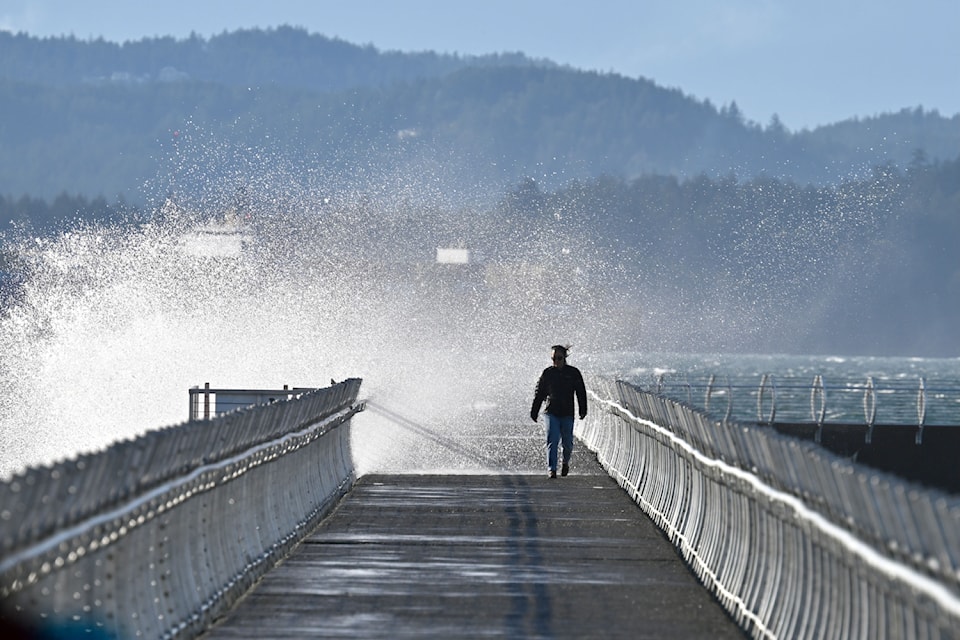The cohesiveness of a community really stands out when blazing embers are blasting across the neighbourhood, according to a Vancouver Island emergency planning officer.
Erin Stockill of Saanich saw it firsthand when a large under-construction condo complex caught fire during this week's windstorm and neighbouring residents were removed from their homes in the wee hours of Nov. 20.
“We really encourage people to get to know their neighbours,” Stockill said. “We certainly saw the importance and difference it can make to know your neighbours and support them.”
The structure fire didn’t come with a warning, but the windstorm did. With rapidly improving information and technology, the heads-up on extreme weather comes earlier and earlier.
Even as some Island residents awaited the return of power or opening of roads, a second wind alert for Vancouver Island sent some into a new tizzy. The second bout expected to arrive Friday (Nov. 22) promises to be weaker than the first, with winds peaking in the 80 km/h range, said Yimei Li, meteorologist with Environment and Climate Change Canada. The latest low pressure is less intense than the previous, she said, noting it should be relatively quiet for a few days, though temperatures are dipping. Overnight lows are anticipated near 0 C for Nov. 26.
Experts suggest using the days where the weather is a little better to hazard hunt in the yard; perhaps packing up the patio furniture before it starts to blow and look at trees that may need a little TLC after a dry summer or extra wet fall.
“Take advantage and do that now,” Stockill said.
She wants folks to reflect on the moments ahead of the bomb cyclone that recently raged across the coast, leaving more than 320,000 BC Hydro customers without power at its peak.
“What items could I have had at home that would make me feel more prepared and more resilient?” Stockill said. “Take those little steps toward preparedness for a power outage and you’re more ready for a larger event.”
As fall slides into winter, Stockill recommends residents identify a bad-weather buddy, making those connections while the sun shines, so both parties are ready when it gets gross, or worse.
“That’s a free way to take steps toward preparedness,” she said. “Make those connections now, especially if we’re looking at snow in the coming winter months.”
Autumn in Greater Victoria has been wetter than normal according to Li’s data.
From Sept. 1 to Nov. 18, the University of Victoria weather station saw 225 mm of rain, 24 per cent above normal, Victoria Gonzales saw 210 mm of rain, 36 per cent above normal, and there was 246 mm of rain at the Victoria International Airport, four per cent above normal for the same period in previous years.
Forecasters say a wetter, colder winter is on the horizon. That likely means snow.
“With a La Nina year, there’s always the possibility there could be some snow. We don’t always get snow for the South Coast but for La Nina years it’s more likely because it’s colder and wetter,” Li said.
While there’s no snow anticipated at the moment, snowflakes have appeared in the forecast for parts of Vancouver Island and temperatures are expected to dip into that territory. People should start planning early and register for municipal alert programs or apps. They should also pay attention to provincial alerts that warn of expected flooding, tsunami and now even earthquakes. Those are free.
Another item on the preparation agenda is sitting down and creating a family plan.
“We all know we're in a time where the cost of living is astronomical and there can be hesitation to take steps toward preparedness because of costs,” Stockill said, a proponent of thrifting and re-purposing where possible.
Start small, she suggests, following checklists and supports online.
Find some of the Saanich supports at saanich.ca and find federal preparedness tips at getprepared.gc.ca.



